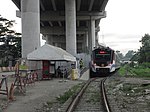Caloocan Cathedral
20th-century Roman Catholic church buildings in the PhilippinesBuildings and structures in CaloocanRoman Catholic cathedrals in the PhilippinesRoman Catholic churches completed in 1981Roman Catholic churches in Metro Manila

Caloocan Cathedral, known canonically as San Roque Cathedral-Parish, is the cathedral or seat of the Roman Catholic Diocese of Kalookan, located near the intersection of 10th Avenue and A. Mabini Street in Poblacion, Caloocan, Metro Manila, Philippines. The church is located some meters away from the poblacion or central vicinity of the city. Its present parish priest is Pablo Virgilio S. David, D.D., the Roman Catholic Bishop of Kalookan, and its rector is Jeronimo Maria J. Cruz, V.G. The cathedral is dedicated Saint Roch, known as San Roque in the Philippines.
Excerpt from the Wikipedia article Caloocan Cathedral (License: CC BY-SA 3.0, Authors, Images).Caloocan Cathedral
A. Mabini Street, Carabaocanibal Poblacion (District 2)
Geographical coordinates (GPS) Address Nearby Places Show on map
Geographical coordinates (GPS)
| Latitude | Longitude |
|---|---|
| N 14.650277777778 ° | E 120.97277777778 ° |
Address
A. Mabini Street
A. Mabini Street
1409 Carabaocanibal, Poblacion (District 2)
Philippines
Open on Google Maps









